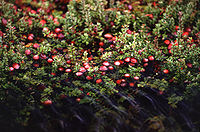
Phytoplasma Infection of Cranberry Affects Development and Oviposition, but Not Host-Plant Selection, of the Insect Vector Limotettix vaccinii
Sign Up to like & getrecommendations! Published in 2019 at "Journal of Chemical Ecology"
DOI: 10.1007/s10886-019-01137-6
Abstract: Vector-borne pathogens, such as phytoplasmas, are known to manipulate both host plants and insect vectors to enhance their own transmission. In cranberries, phytoplasma infection causes false blossom disease, which is vectored by blunt-nosed leafhoppers (Limotettix… read more here.
Keywords: cranberry; vector; infection; phytoplasma infection ... See more keywords

Combination of iTRAQ proteomics and RNA-seq transcriptomics reveals multiple levels of regulation in phytoplasma-infected Ziziphus jujuba Mill
Sign Up to like & getrecommendations! Published in 2017 at "Horticulture Research"
DOI: 10.1038/hortres.2017.80
Abstract: Jujube witches’ broom (JWB) is caused by infection with a phytoplasma. A multi-omics approach was taken during graft infection of jujube by JWB-infected scion through the analysis of the plant transcriptome, proteome and phytohormone levels.… read more here.
Keywords: biosynthesis; combination itraq; infection; phytoplasma infection ... See more keywords

Changing Host Photosynthetic, Carbohydrate, and Energy Metabolisms Play Important Roles in Phytoplasma Infection.
Sign Up to like & getrecommendations! Published in 2018 at "Phytopathology"
DOI: 10.1094/phyto-02-18-0058-r
Abstract: Phytoplasmas parasitize plant phloem tissue and cause many economically important plant diseases. Jujube witches'-broom disease is a destructive phytoplasma disease of Chinese jujube (Ziziphus jujuba). To elucidate the influence of phytoplasma on host photosynthetic, carbohydrate… read more here.
Keywords: phytoplasma infection; energy metabolisms; carbohydrate; host ... See more keywords

Regulation of Long Noncoding RNAs Responsive to Phytoplasma Infection in Paulownia tomentosa
Sign Up to like & getrecommendations! Published in 2018 at "International Journal of Genomics"
DOI: 10.1155/2018/3174352
Abstract: Paulownia witches' broom caused by phytoplasma infection affects the production of Paulownia trees worldwide. Emerging evidence showed that long noncoding RNAs (lncRNA) play a protagonist role in regulating the expression of genes in plants. So… read more here.
Keywords: long noncoding; phytoplasma infection; noncoding rnas; paulownia tomentosa ... See more keywords

The Crosstalk of the Salicylic Acid and Jasmonic Acid Signaling Pathways Contributed to Different Resistance to Phytoplasma Infection Between the Two Genotypes in Chinese Jujube
Sign Up to like & getrecommendations! Published in 2022 at "Frontiers in Microbiology"
DOI: 10.3389/fmicb.2022.800762
Abstract: Jujube witches’ broom disease (JWB), one of the most serious phytoplasma diseases, usually results in the destruction of Chinese jujube (Ziziphus jujuba Mill.). Although most jujube cultivars are sensitive to JWB, we found a few… read more here.
Keywords: chinese jujube; jujube; acid; phytoplasma infection ... See more keywords

Application of Plant Defense Elicitors Fails to Enhance Herbivore Resistance or Mitigate Phytoplasma Infection in Cranberries
Sign Up to like & getrecommendations! Published in 2021 at "Frontiers in Plant Science"
DOI: 10.3389/fpls.2021.700242
Abstract: Synthetic elicitors of the salicylic acid (SA) and jasmonic acid (JA) plant defense pathways can be used to increase crop protection against herbivores and pathogens. In this study, we tested the hypothesis that elicitors of… read more here.
Keywords: plant; infection; elicitor; phytoplasma infection ... See more keywords